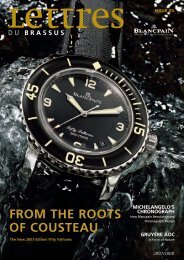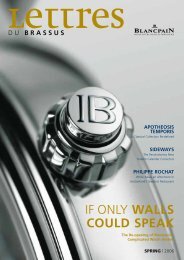THE HISTORY OF BLANCPAIN
THE HISTORY OF BLANCPAIN
THE HISTORY OF BLANCPAIN
You also want an ePaper? Increase the reach of your titles
YUMPU automatically turns print PDFs into web optimized ePapers that Google loves.
IN TIME<br />
ing his thoughts onto the wax rolls of the<br />
machine and, depositing the rolls in the<br />
mail, trusting his orders would be carried<br />
out. Had he lived 70 years later, it is clear<br />
that Frédéric-Emile would have been in the<br />
forefront as a Blackberry addict (now affectionately<br />
known as “Crackberry”).<br />
Relying on the stream of wax rolls running<br />
between Lausanne and Villeret and reposing<br />
full confidence in Betty Fiechter’s talents as a<br />
manager, Frédéric-Emile devoted himself to<br />
both expansion of Blancpain’s markets and<br />
the design of record-breaking movements.<br />
For the first time, Blancpain looked across<br />
the Atlantic, sending its marketing director,<br />
André Léal, over to the United States.<br />
On the movement side, Frédéric-Emile was<br />
particularly fascinated by the challenges<br />
of automatic winding. In the mid-1920s he<br />
made the acquaintance of a British watchmaker,<br />
John Harwood who had been working<br />
on bringing an automatic winding system,<br />
then solely existing in pocket watches,<br />
into the world of wristwatches. Working<br />
together and utilising as a starting point one<br />
of Blancpain’s base calibres, Harwood and<br />
Blancpain succeeded in 1926 in producing the<br />
world’s first automatic winding wristwatch.<br />
Amazing for its time, the Blancpain Harwood<br />
watch placed a thick winding rotor off the<br />
end of the movement, allowing it to move<br />
back and forth in its channel over a 180<br />
degree arc. Although the achievement of the<br />
world’s first automatic winding system for a<br />
BETTY FIECHTER, PRESIDENT <strong>BLANCPAIN</strong> 1932-1950. VILLERET 1961.<br />
wristwatch propelled the watch to the starring<br />
position at that year’s Basel fair, the<br />
innovations did not stop there. To fight dust,<br />
a brutal wristwatch enemy before modern<br />
seals were developed, the crown was<br />
removed and the watch featured a system<br />
for setting the time by rotating the bezel.<br />
Frédéric-Emile’s second foray into automatic<br />
winding came a few years later in 1930<br />
with the introduction of the Rolls women’s<br />
watch. Again working in collaboration with<br />
outsiders, Blancpain perfected a scheme for<br />
automatically winding ladies watches which<br />
were far too diminutive to accommodate a<br />
rotor. Here the ingenious solution was to<br />
place the entire movement into a carriage<br />
that would allow it to slide back and forth,<br />
thereby recharging the mainspring. To facilitate<br />
the sliding, the watch was fitted with<br />
ball bearings between the movement and its<br />
carriage. Again a world first was won as the<br />
Rolls, a name invented by Blancpain for selling<br />
the watch, earned its place as the first<br />
automatic winding wristwatch for women.<br />
Frédéric-Emile’s string of successes came to<br />
a tragic close with his sudden death in 1932.<br />
Lost at the same time was the Blancpain family<br />
name, as he left no male heirs. There were<br />
however capable hands to take over the<br />
Blancpain enterprise, those of Betty Fiechter,<br />
who, together with the Blancpain sales director<br />
André Leal, purchased the business in<br />
June 1933, renaming it Rayville-Blancpain,<br />
Rayville being a phonetic anagram of Villeret.<br />
Owing to an oddity of Swiss law, this name<br />
change was not optional. With no member<br />
of the Blancpain family remaining associated<br />
with the business, the new owners were<br />
required to alter the official business name<br />
(the gymnastics provoked by this regulation<br />
have, over time, led to bizarre solutions with<br />
one famous Geneva watch company searching<br />
for and hiring a person “with the right<br />
last name” in order to continue their hyphenated<br />
trademark).<br />
There is a touching letter marking the transfer<br />
of Blancpain after 200 years within the<br />
founding family to Betty Fiechter. Frédéric-<br />
Emile’s daughter, Nellie wrote to Betty:<br />
“The end of Villeret for Papa brings real sadness,<br />
but I can assure you that the only solution<br />
which can truly ease my sadness is your<br />
taking over of the manufacture together<br />
with Mr. Leal. Thanks to this fortunate solution<br />
I can see that the traditions of our<br />
precious past will be followed and respected<br />
in every way.<br />
You were for Papa a rare and dear collaborator.<br />
One more time let me thank you for<br />
your great and lasting tenderness which<br />
I embrace and carry with me in my heart.”<br />
The early days were not easy for Betty<br />
Fiechter. The Great Depression walloped the<br />
entirety of the Swiss watch industry, causing<br />
widespread business failures and producing<br />
massive unemployment. Blancpain’s solution<br />
was to seek refuge in the American market,<br />
which by the mid-30s was in sounder condi-







